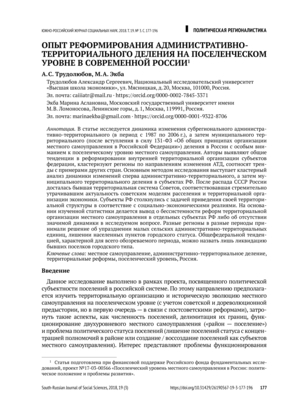Abstract
The article examines the dynamics of the sub-regional administrative and territorial divisions (since 1987 to 1995) and municipal and territorial divisions in Russia (after Federal Law № 131 came into force), with special attention to the localities’ level of local selfgovernment. The authors detect common trends in the reform of the regional territorial organizations, to group regions in accordance with the changes in the AD, and to correlate the trends with those of other countries. The key method of research is cluster analysis of the dynamics of changes, first in the administrative and later in the municipal divisions of the Russian Federation regions. After the collapse of the Soviet Union, Russia has inherited the former territorial system of the “soviets”, coherent in conformity with the Soviet models of population distribution and territorial economic structure which were no longer actual. The Russian Federation regions faced the necessity to bring their administrative division into line with socioeconomic reality. On the basis of statistical data, the authors assert that the reforms of the territorial structure of local selfgovernment in some regions of the Russian Federation are unsystematic, or that there is no significant development. Different regions in the different periods made decisions to annul small rural localities settlements or to deprive some settlements of their city status. The only viable federal trend that can be traced over the period under research has been the elimination of urban-type settlements.
Keywords
Funding information
The research was carried out through the financial support of The Russian Foundation for Basic Research: research project № 17-03-00566 “Settlement-level municipalities in Russia: political position and problems of development”.
References
Дергачев, В., Макутина, М. Госдума в ускоренном режиме рассмотрит поправки о ликвидации поселений. (2017, Март 10). РБК. Режим доступа http://www.rbc.ru/politics/10/03/2017/58c29f429a7947596181c66d
Дроботенко, И.И. (2010). Зарубежные модели местного самоуправления: опыт для России. Власть, 1, 119–122.
Закон Российской Федерации «О местном самоуправлении в Российской Федерации» от 06.07.1991 г. № 1550–1. (1991). Режим доступа http://www.consultant.ru/document/cons_doc_LAW_105/
Закон СССР «Об общих началах местного самоуправления и местного хозяйства в СССР» от 09.04.1990 № N1418–1. (1990). Режим доступа http://www.zaki.ru/pagesnew.php?id=1687
Закон Российской Федерации «Об общих принципах организации местного самоуправления в Российской Федерации» от 28.08.1995 № 154-ФЗ. (1995). Режим доступа http://www.consultant.ru/document/cons_doc_LAW_7642/
Закон Российской Федерации «Об общих принципах организации местного самоуправления в Российской Федерации» от 06.10.2003 г. № 131-ФЗ. (2003). Режим доступа http://www.consultant.ru/document/cons_doc_LAW_44571/
Клейменов, С.П. (2012). Административный и экономический факторы пространственного развития Псковской области: история и современность. Псковский регионологический журнал, 14, 187–200.
Маркварт, Э.Э., Йохен, Ф. (2017). Территориальное реформирование местного самоуправления в Германии и России на современном этапе. Пространственная экономика, 3, 40–61. DOI: 10.14530/se.2017.3.040–061
Постановление ЦК ВКП (б) о ликвидации округов от 15 июля 1930 г. Режим доступа http://istmat.info/node/48987
Тархов, С.А. (2005). Изменение административно-территориального деления России в XIII–XX вв. Пространственная организация хозяйства: ТПК, или кластеры. Москва: ИГ РАН.
Транин, А.А. (1984). О понятии административно-территориальной организации капиталистического государства. В Г.В. Барабашев (ред.) Административно-территориальная организация капиталистического государства (с. 8–14). Москва: Наука.
Туровский, Р.Ф. (2006). Центр и регионы: проблемы политических отношений. Москва: Издательский дом ГУ ВШЭ.
Чиркин, В.Е. (2014). Публичное управление «на местах»: некоторые вопросы российского и зарубежного опыта. Журнал российского права, 10, 39–48. DOI: 10.12737/5773
Численность населения Российской Федерации по муниципальным образованиям. Федеральная служба государственной статистики. (2018). Режим доступа http://www.gks.ru/wps/wcm/connect/rosstat_main/rosstat/ru/statistics/publications/catalog/afc8ea004d56a39ab251f2bafc3a6fce
Эксперты КГИ сравнили практику муниципальных территориальных преобразований в России и Европе. Режим доступа https://komitetgi.ru/news/news/3452/
Charbit, C., Michalun, M. (2009). Mind the gaps: Managing Mutual Dependence in Relations among Levels of Government. OECD Working Papers on Public Governance, 14, OECD Publishing. DOI: 10.1787/221253707200
Multi-level Governance: overview of OECD Country experience. (2017). OECD Multi-level Governance Studies. DOI: 10.1787/9789264272866-en
Parishes Names and Codes in England and Wales (2016). Office for National Statistics. Режим доступа http://geoportal.statistics.gov.uk/datasets/parishes-december‑2016-names-and-codes-in-england-and-wales
Population by the 2017 administrative reform (2017). Statistics Estonia. Режим доступа http://www.stat.ee/sdb-update?db_update_id=20303


